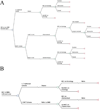Traditional versus streamlined management of basal cell carcinoma (BCC): A cost analysis
- PMID: 26341142
- PMCID: PMC5031151
- DOI: 10.1016/j.jaad.2015.07.021
Traditional versus streamlined management of basal cell carcinoma (BCC): A cost analysis
Abstract
Background: Facing rising incidence of basal cell carcinoma (BCC) and increasing pressure to contain health care spending, physicians need to contemplate cost-effective paradigms for managing BCC.
Objective: We sought to perform a cost analysis comparing the traditional BCC management scheme with a simplified detect-and-treat scheme that eliminates the biopsy before initiating definitive treatment.
Methods: A decision analytic model was developed to compare the costs of traditional BCC management with the detect-and-treat scheme, under which qualifying lesions diagnosed clinically were either treated with shave removal or referred to Mohs micrographic surgery for on-site histologic check. Values for model parameters were based on literature and our institutional data analysis. Costs were based on 2014 Medicare fee schedule.
Results: The average cost per lesion with detect-and-treat scheme was $449 for non-Mohs micrographic surgery-indicated lesions (vs $566 with traditional management, $117 in savings) and $819 for Mohs micrographic surgery-indicated lesions (vs $864 with traditional management, $45 in savings). The combined weighted average savings per case was $95 (15% of total average cost). Conclusions were similar under various plausible scenarios.
Limitations: Model parameter values may vary based on individual practices.
Conclusions: A simplified management strategy eliminating routine pretreatment biopsy can reduce BCC treatment cost without compromising quality of care.
Keywords: basal cell carcinoma; chemocheck; cost analysis; decision analysis model; detect-and-treat scheme; shave removal.
Copyright © 2015 American Academy of Dermatology, Inc. Published by Elsevier Inc. All rights reserved.
Conflict of interest statement
The authors have no potential conflicts of or competing interests to disclose.
Figures



Similar articles
-
A relative value unit-based cost comparison of treatment modalities for nonmelanoma skin cancer: effect of the loss of the Mohs multiple surgery reduction exemption.J Am Acad Dermatol. 2009 Jul;61(1):96-103. doi: 10.1016/j.jaad.2008.07.047. J Am Acad Dermatol. 2009. PMID: 19539843
-
Mohs micrographic surgery: a cost analysis.J Am Acad Dermatol. 1998 Nov;39(5 Pt 1):698-703. doi: 10.1016/s0190-9622(98)70041-6. J Am Acad Dermatol. 1998. PMID: 9810885
-
Surgical excision versus Mohs' micrographic surgery for primary and recurrent basal-cell carcinoma of the face: a prospective randomised controlled trial with 5-years' follow-up.Lancet Oncol. 2008 Dec;9(12):1149-56. doi: 10.1016/S1470-2045(08)70260-2. Epub 2008 Nov 17. Lancet Oncol. 2008. PMID: 19010733 Clinical Trial.
-
Cost effectiveness of Mohs micrographic surgery: review of the literature.J Drugs Dermatol. 2009 Oct;8(10):914-22. J Drugs Dermatol. 2009. PMID: 19852120 Review.
-
Mohs' micrographic surgery for treatment of basal cell carcinoma of the face--results of a retrospective study and review of the literature.Br J Dermatol. 2004 Jul;151(1):141-7. doi: 10.1111/j.1365-2133.2004.06047.x. Br J Dermatol. 2004. PMID: 15270883 Review.
Cited by
-
Proposal of a new dermoscopic criterion for pigmented basal cell carcinoma: a multicentre retrospective study.Dermatol Reports. 2023 Aug 24;16(1):9691. doi: 10.4081/dr.2023.9691. eCollection 2024 Mar 12. Dermatol Reports. 2023. PMID: 38623374 Free PMC article.
-
Association of Multiple Aggregated Yellow-White Globules With Nonpigmented Basal Cell Carcinoma.JAMA Dermatol. 2020 Aug 1;156(8):882-890. doi: 10.1001/jamadermatol.2020.1450. JAMA Dermatol. 2020. PMID: 32459294 Free PMC article.
-
Deep Shave Removal of Suspected Basal Cell Carcinoma: A Prospective Study.Dermatol Surg. 2023 Feb 1;49(2):130-134. doi: 10.1097/DSS.0000000000003680. Epub 2022 Dec 26. Dermatol Surg. 2023. PMID: 36728062 Free PMC article.
References
-
- Rogers HW, Weinstock MA, Harris AR, et al. Incidence Estimate of Nonmelanoma Skin Cancer in the United States, 2006. Arch Dermatol. 2010 Mar 10;146(3):283–287. - PubMed
-
- Mudigonda T, Pearce DJ, Yentzer BA, Williford P, Feldman SR. The Economic Impact of Non- Melanoma Skin Cancer: A Review. J Natl Compr Canc. Ne. 2010 Aug;8(8):888–896. - PubMed
-
- Bath-Hextall F, Leonardi-Bee J, Smith C, Meal A, Hubbard R. Trends in incidence of skin basal cell carcinoma. Additional evidence from a UK primary care database study. Int J Cancer. 2007 Nov 1;121(9):2105–2108. - PubMed
-
- Chen JG, Fleischer AB, Jr, Smith ED, et al. Cost of nonmelanoma skin cancer treatment in the United States. Dermatol Surg. 2001 Dec;27(12):1035–1038. - PubMed
-
- Kimball AB, Resneck JS., Jr The US dermatology workforce: a specialty remains in shortage. Journal of the American Academy of Dermatology. 2008 Nov;59(5):741–745. - PubMed
MeSH terms
Grants and funding
LinkOut - more resources
Full Text Sources
Other Literature Sources
Medical

